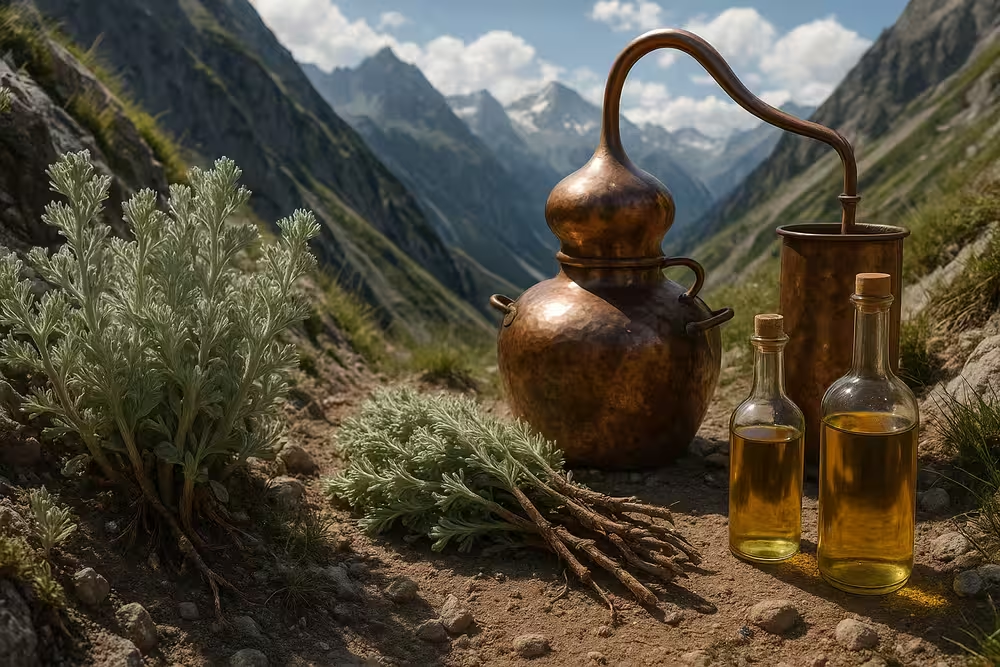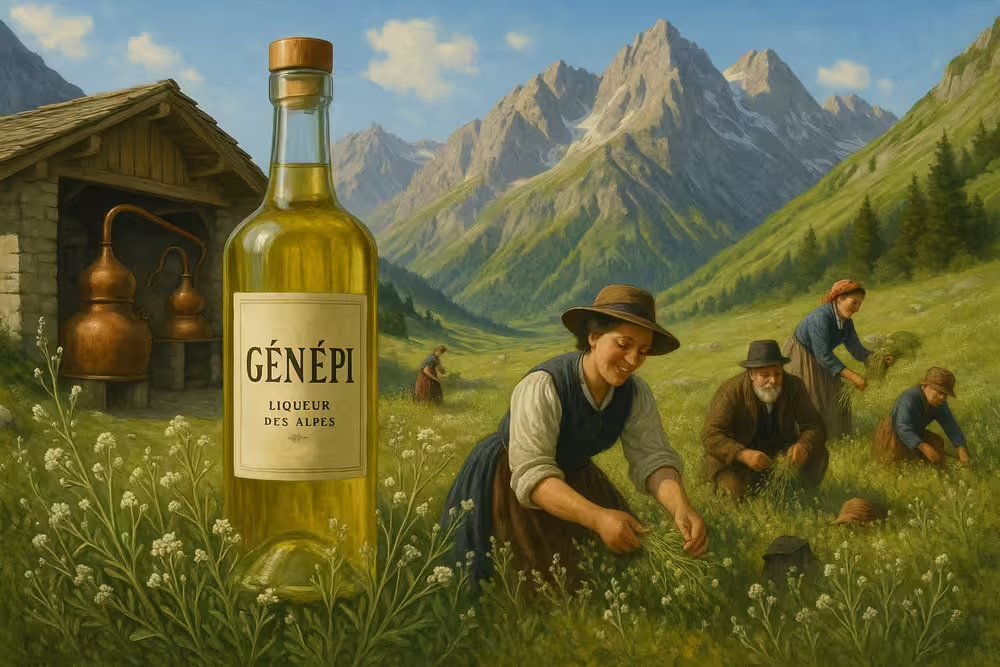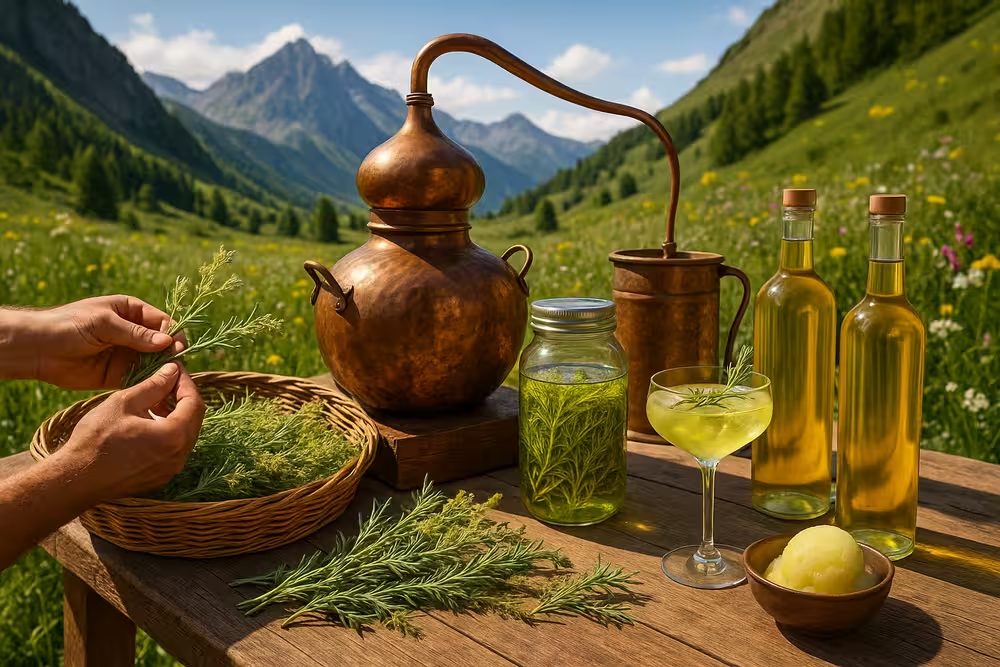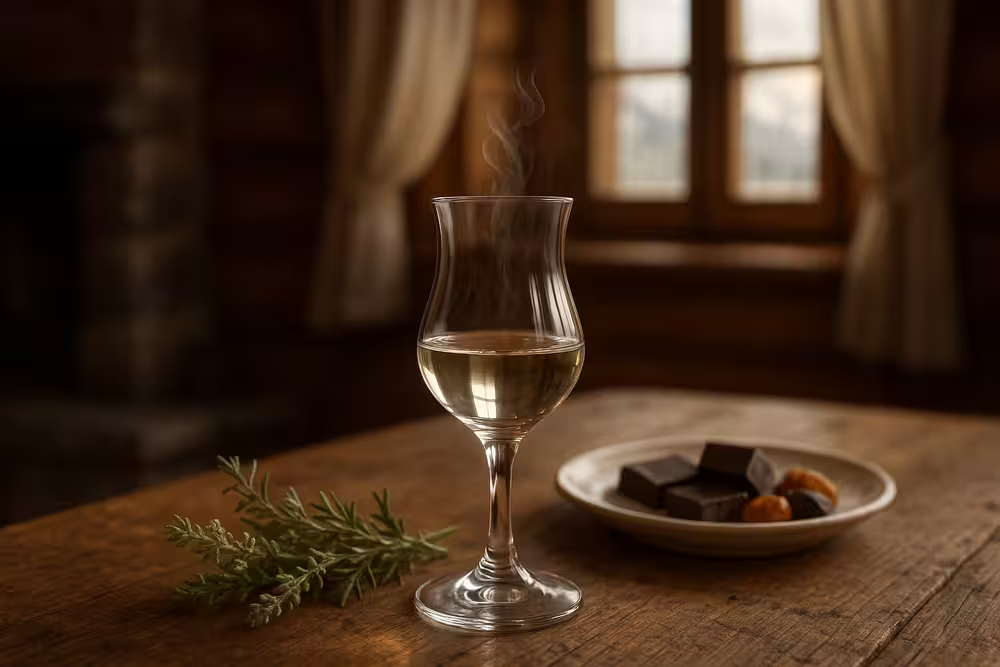Alpine Génépi: tips and recipes
Explore the history, artisanal production, and authentic recipes of Alpine Génépi, an iconic liqueur with botanical flavors, symbolizing tradition and the wild nature of the mountains.
Alpine Génépi: tips and recipes
Introduction
Discover the history, production, and tips for enjoying Génépi, an ancestral Alpine treasure, with authenticity and passion.
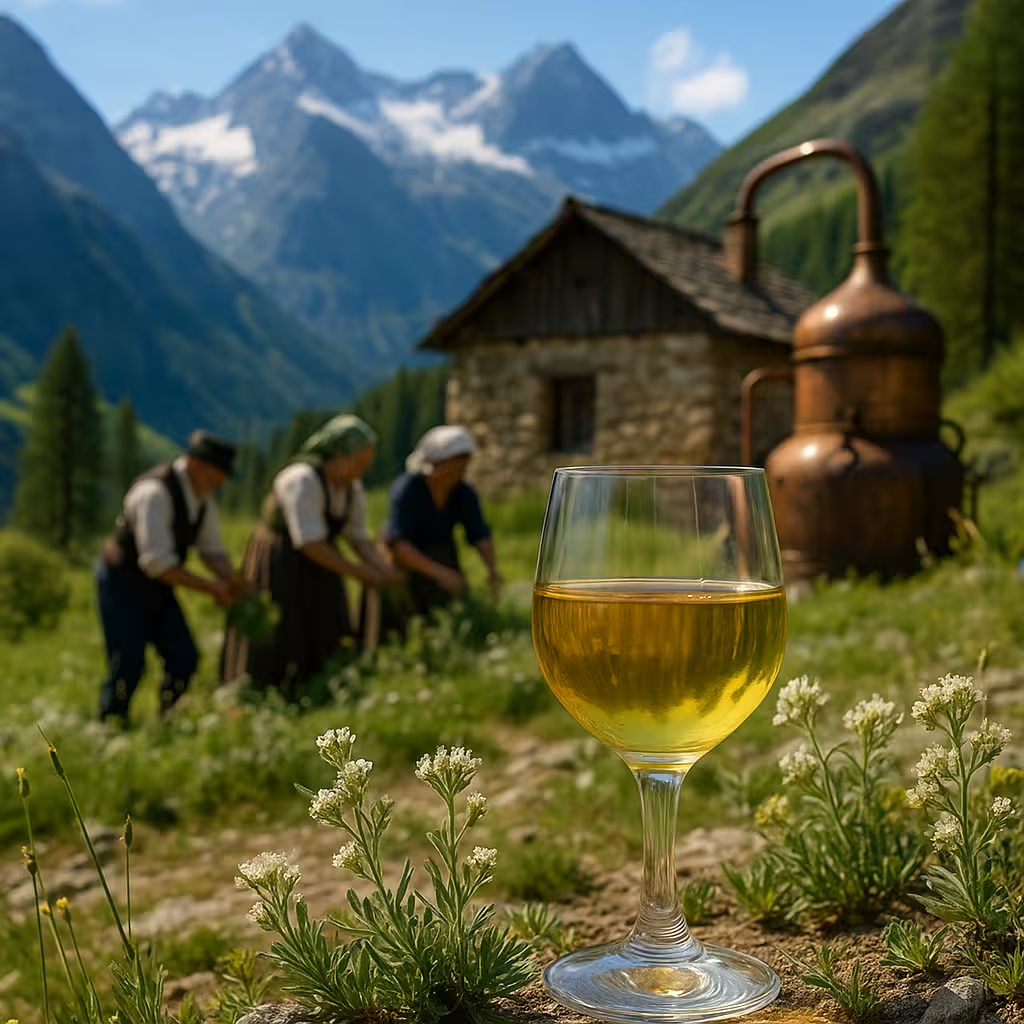
Discover the fascinating world of Alpine Génépi, an iconic liqueur that embodies the richness of mountain traditions. Its unique aroma, blending botanical notes with ancestral craftsmanship, evokes the wild beauty of the Alpine peaks. Through its captivating history, artisanal production methods, and authentic recipes, embark on a sensory journey where every sip tells a story. Whether you are a lover of distinctive spirits or simply curious to explore a regional treasure, this article unveils all the secrets to fully appreciating this exceptional drink.
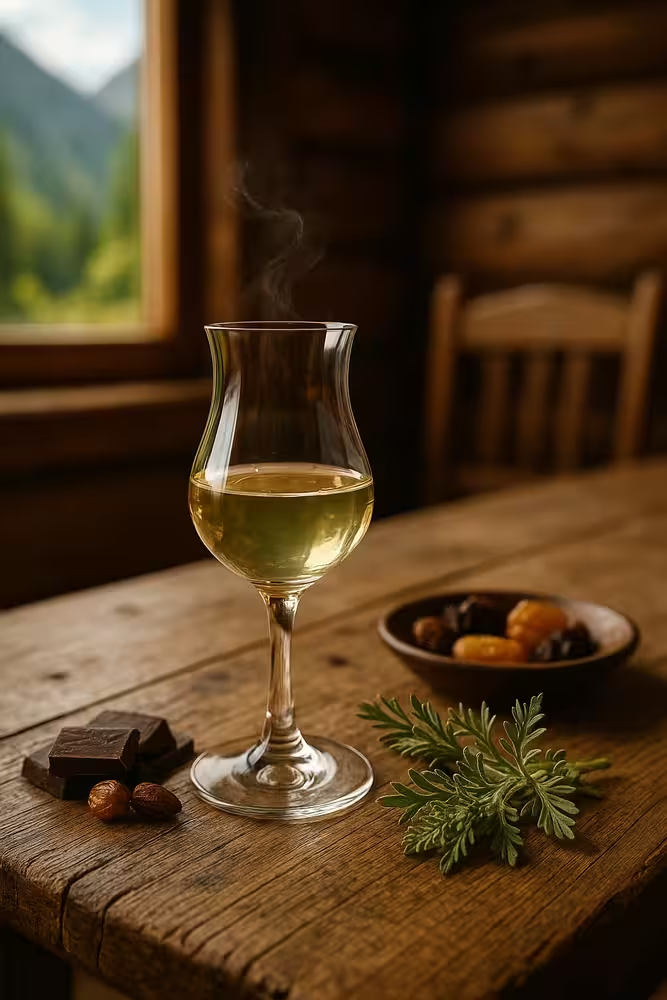
Alpine Génépi: history, production, recipes, and tips for an authentic tasting experience
Origins and History of Génépi: An Ancestral Treasure of the Alps
Geographical and ethnographic origins of Génépi
Génépi, the iconic liqueur of the Alpine peaks, has its roots in a terroir rich in tradition and biodiversity. Its name likely derives from the local term "genep," referring to a specific aromatic plant that grows at high altitudes in mountain ecosystems. The regions of Savoie, Haute-Savoie, and the Aosta Valley in Italy form the historical heartland of this medicinal and spirited plant. Alpine vegetation, adapted to extreme conditions, offers a variety of wild Génépi, whose annual flowering marks the agricultural and cultural cycle of mountain communities. Harvesting, often done by hand during the summer months, reflects ancestral know-how passed down through generations, shaping a strong regional identity.
Historical evolution and Alpine traditions associated with the plant
Since ancient times, Génépi has held a central place in local pharmacopoeia. Initially used for its medicinal properties, it gradually became part of festive rituals and convivial gatherings. Over the centuries, artisanal distillation developed, allowing the extraction of its precious aromatic essences. Traditionally, each family safeguarded its own production secrets, preserving a discreet yet valuable savoir-faire. The rise in popularity of Génépi in the 19th century coincided with the growth of Alpine tourism, where the liqueur became a symbol of local authenticity. Oral transmission and artisanal practices have thus shaped a unique culture, now part of the intangible heritage of the Alps.
Cultural and symbolic role in mountain communities
More than just an elixir, Génépi embodies the spirit of the mountains—resilience in the face of nature’s elements and a deep sense of community. During traditional gatherings, it serves as a social bond, strengthening communal ties. Its captivating aroma evokes the purity of the Alpine landscape, while its tasting becomes an act of celebrating nature and local craftsmanship. The plant itself, often regarded as a good luck charm or remedy, is revered during seasonal festivals that honor the plant’s life cycle and the enduring power of the mountains. As a symbol, Génépi transcends simple consumption to become a cultural emblem, representing the intangible heritage of Alpine peoples.
The history of distillation and the use of Génépi through the centuries
The art of distilling Génépi dates back several centuries, with artisanal techniques passed down from master distiller to apprentice. Distillation, often carried out in copper stills, extracts a concentrated essence with subtle and complex aromas. Over time, this practice has evolved through local expertise, incorporating maceration and fermentation methods that enhance its aromatic richness. The consumption of Génépi has diversified, shifting from medicinal use to festive and contemplative enjoyment. Modern regulations have helped preserve this tradition while ensuring authentic quality, protecting both geographical specificity and artisanal methods from the pressures of industrial production. The long history of Génépi reflects its deep importance within Alpine cultural heritage—a true ancestral treasure.
Alpine Génépi: history, production, recipes, and tips for an authentic tasting experience
Génépi Production Process: From Plant to Bottle
2.1. Identification and harvesting of Génépi plants: species and seasonality
The search for authentic Génépi begins with a meticulous identification of its signature species, primarily Artemisia umbelliformis, Artemisia glacialis, and Artemisia genipi. These discreet varieties, often hidden among the steep heights of the Alps, require a deep understanding of their morphology and biological cycle. Harvesting typically takes place at the end of summer, when the plant reaches its aromatic peak, just before flowering. Seasonality is crucial: harvesting too early would yield bland leaves, while a late harvest could compromise the delicacy of the aromatic compounds. The picking process must be respectful, ensuring the sustainability of the Alpine ecosystem and avoiding overharvesting that could disrupt local biodiversity. Careful selection of plants goes hand in hand with a deep respect for the environment, preserving the purity and authenticity of the final product—a true reflection of the mountain terroir.
Traditional maceration and distillation techniques
Once harvested, the transformation of Génépi relies on age-old methods passed down through generations. Maceration is the first essential step: the leaves and flowering tops are immersed in a neutral alcohol, often fruit or grain brandy, at a controlled temperature. The maceration period varies depending on the recipe, ranging from a few days to several weeks, allowing the subtle aromas to infuse and intensify. Distillation takes place in copper stills, where gentle heat vaporizes the mixture, capturing and condensing the precious essences. Traditional distillation focuses on achieving finesse and preserving aromatic compounds, particularly sesquiterpenes and the distinctive terpenic aromas of Génépi. Mastery of these artisanal techniques imparts the liqueur with a unique olfactory and gustatory complexity, true to its Alpine origins.
Aromatic composition and maturation process
Génépi is distinguished by a rich and captivating aromatic palette, blending resinous, herbal, and slightly sweet notes. Phenolic compounds, such as sesquiterpenes, impart a woody and spicy flavor to the spirit, while terpenes contribute freshness and vibrancy. Bottle maturation, often extended over several months, allows the aromas to meld harmoniously, unveiling the full complexity of the distillate. This aging process also promotes the evaporation of undesirable volatile components, enhancing the smoothness and balance of the Génépi. Patience is a key virtue in this stage, as it elevates the very essence of the plant, resulting in a nectar of subtle nuances—a true reflection of ancestral craftsmanship and the high-altitude terroir.
Standards and regulations for authentic and high-quality production
To ensure its authenticity and quality, the production of Génépi must adhere to strict guidelines. In France, particularly in Alpine regions, the Controlled Designation of Origin (AOC) or Protected Designation of Origin (PDO) imposes specific criteria regarding the plant species used, harvesting methods, composition of the base alcohol, and distillation techniques. These regulations aim to preserve the product’s authenticity, preventing industrial counterfeits or artificial additives. Traceability and clear labeling are also essential to inform consumers about the origin and production method. Certification thus guarantees a Génépi that respects tradition, cultivated and distilled in harmony with the environment, while preserving its original mountain-borne organoleptic qualities. Compliance with these standards is key to fully appreciating the richness and uniqueness of this precious Alpine elixir.
Alpine Génépi: history, production, recipes, and tips for an authentic tasting experience
Génépi Recipes and Variations: Exploring the Diversity of Tasting Experiences
Classic homemade artisanal Génépi recipe
Preparing homemade artisanal Génépi is about embracing an ancestral tradition steeped in rustic charm and refinement. The key lies in the careful selection of plants, typically Génépi needles or young shoots, handpicked during the summer season when their aroma is at its peak. After this delicate harvest, the plants are macerated in a base of neutral alcohol—often fruit or grain brandy—combined with a light touch of sugar to soften the potion. The maceration process spans several weeks, or even months, allowing the flavors to fully develop. Distillation, an essential step, takes place in a traditional copper still, where steam captures the precious essences. The result is an herbaceous, intensely aromatic elixir, whose finesse depends on the skill of the amateur distiller.
Modern creations and Génépi-based cocktails
The world of Génépi extends far beyond its traditional forms. Contemporary mixologists have incorporated it into a wide range of bold creations, where its complexity truly shines. Génépi pairs beautifully with ingredients such as vanilla, lemon, and mint, making it ideal for crafting innovative cocktails that evoke Alpine freshness while appealing to a younger audience. Among the standout recipes, Génépi served in an iced cocktail with a splash of tonic or artisanal soda offers a refreshing and aromatic experience. Some also experiment by incorporating Génépi into desserts, such as sorbets or panna cotta, where its herbal notes provide a delightful contrast to sweet flavors. These modern creations highlight the versatility of this iconic liqueur while honoring its authentic roots.
Tips for balancing flavors and intensity during tasting
To fully appreciate the richness of Génépi, it is essential to adopt a balanced approach during tasting. The first step is selecting the right temperature—slightly chilled but not ice-cold—to reveal its aromatic subtleties without masking them. The serving size should be moderate, allowing one to savor its complexity without letting the alcohol overpower the experience. When tasting, it is advisable to take time to gently inhale its aromas, focusing on the herbal, floral, or spicy notes. Slow, deep breathing helps to detect the full olfactory palette. Finally, pairing should be chosen with care: dried fruits, dark chocolate, or a slice of hard cheese can balance Génépi’s intensity, creating a harmonious tasting experience that enhances its intrinsic qualities.
Advice on pairing Génépi with other ingredients and typical Alpine dishes
The art of pairing Génépi with other ingredients relies on a refined understanding of its aromatic nuances. It pairs beautifully with local and typical Alpine products such as Tomme cheese, Raclette, or wild berries, which enhance its herbal and floral notes. When incorporated into culinary recipes, Génépi can elevate dishes like fondue by adding a subtle aromatic touch, or it can flavor sauces for white meats. In desserts, it enhances creams, sorbets, or fruit tarts, bringing an additional layer of aroma. For a harmonious tasting experience, it is advisable to experiment in moderation, adjusting the amount of Génépi so as not to overpower the delicacy of the other ingredients. The key lies in achieving a subtle balance, where each component reveals its qualities without dominating the whole, allowing one to fully appreciate the richness of Alpine tradition.
Alpine Génépi: history, production, recipes, and tips for an authentic tasting experience
Tips for an Authentic and Respectful Génépi Tasting Experience
How to appreciate its aromas and subtle flavors
The art of savoring genuine Génépi lies in paying meticulous attention to its aromas. When tasting, it is recommended to pour a small amount into a tulip-shaped glass or liqueur glass, allowing the bouquet to concentrate. The first step is to gently inhale, letting your nose explore the floral, herbal, and resinous complexity of the elixir. Its rich aromatic profile, often marked by notes of alpine plants, juniper, mint, or spices, reveals itself gradually. The tasting experience should then engage the palate, where sweetness, freshness, and a slight bitterness intertwine, showcasing the finesse of the distillation. Patience and focus are essential to fully perceive the subtlety of this ancestral liqueur—a true aromatic symphony.
Ideal temperature and pairings for tasting
To fully appreciate Génépi, its serving temperature must be carefully controlled. Ideally, it should be enjoyed slightly chilled, between 12 and 14 degrees Celsius, to reveal its aromatic notes without masking them. Excessive chilling could mute its delicate nuances, while serving it too warm might emphasize the alcohol and disrupt its balance. In terms of pairings, tradition favors subtle accompaniments such as dark chocolate, dried fruits, or aged cheeses. Tasting Génépi on its own, in small sips, also allows the senses to fully appreciate its complexity. The key lies in simplicity and in showcasing its intrinsic qualities.
Storage and preservation to maintain quality
Storage and preservation to maintain quality
Preserving the quality of Génépi requires careful storage. The bottle should be kept away from direct light, in a cool, dry place, and protected from temperature fluctuations. Once opened, it is advisable to seal it tightly to prevent oxidation, which could diminish its delicate aromas. The shelf life depends on the composition, but in general, well-stored Génépi can improve over time, gaining roundness and complexity. It is also recommended to avoid storing the bottle near heat sources or areas subject to vibrations, which could compromise the finesse of the distillation. Patience and attentiveness are key to ensuring lasting enjoyment.
How to avoid pitfalls and recognize superior-quality Génépi
The quest for authentic, high-quality Génépi requires vigilance against counterfeits and low-grade products. True Génépi is distinguished by its clarity, rich and balanced aroma, and harmonious flavor. Be wary of bottles with poorly designed labels or those with an overly dark or artificial color. The origin is also a valuable indicator: favor artisanal distilleries or local producers who adhere to traditional methods. Finally, attentive tasting helps detect any chemical notes or imbalances in the aroma. True excellence lies in the product’s complexity, finesse, and authenticity—a reflection of ancestral craftsmanship passed down with passion.
Conclusion
Immerse yourself in the fascinating world of Génépi, a true Alpine treasure rich in history and tradition. Discover its authentic origins, ancestral production methods, and the depth of its flavors. Whether you are a beginner or a connoisseur, explore a variety of recipes and learn how to savor this liqueur with respect and passion. Treat yourself to a unique sensory experience by mastering the art of tasting and choosing a high-quality Génépi. Let yourself be charmed by this iconic beverage, a symbol of mountain culture. Click here to uncover all the secrets of Génépi and embark on an unforgettable taste adventure.
Articles that may interest you
Discover the resort
Our selection of restaurants in Les 2 Alpes
Our selection of stores in Les 2 Alpes
Movies, bowling, laser tag: your indoor activities
Ski schools: our selection
Frequently asked questions
Find answers to the most common questions about our products. Julia ensures transparency, efficiency, and detailed information in everything we do.

Discover tips, trends and ideas to help you prepare for your stay in the mountains, and discover fantastic places and addresses. Julia and the team regularly prepare new articles for you, so don't hesitate to visit our blog regularly.
Find the best moments from your article
